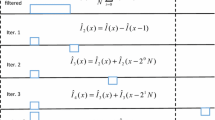Abstract
We present an efficient approach for high-quality non-blind deconvolution based on the use of sparse adaptive priors. Its regularization term enforces preservation of strong edges while removing noise. We model the image-prior deconvolution problem as a linear system, which is solved in the frequency domain. This clean formulation lends to a simple and efficient implementation. We demonstrate its effectiveness by performing an extensive comparison with existing non-blind deconvolution methods, and by using it to deblur photographs degraded by camera shake. Our experiments show that our solution is faster and its results tend to have higher peak signal-to-noise ratio than the state-of-the-art techniques. Thus, it provides an attractive alternative to perform high-quality non-blind deconvolution of large images, as well as to be used as the final step of blind-deconvolution algorithms.










Similar content being viewed by others
References
Banham, M., Katsaggelos, A.: Digital image restoration. Signal Process. Mag. IEEE 14(2), 4–41 (1997)
Ben-Ezra, M., Nayar, S.: Motion-based Motion Deblurring. IEEE TPAMI 26(6), 689–698 (2004)
Bonesky, T.: Morozov’s discrepancy principle and tikhonov-type functionals. Inverse Probl. 25(1), 015015 (2009)
Cai, J.-F., Ji, H., Liu, C., Shen, Z.: Blind motion deblurring from a single image using sparse approximation. In: CVPR 2009. pp 104–111 (2009)
Campisi, P., Egiazarian, K.: Blind Image Deconvolution: theory and Applications. CRC Press, Boca Raton (2007)
Cho, S., Lee, S.: Fast motion deblurring. ACM Trans. Graph. 5(28), 145 (2009). (1–145:8)
Cho, S., Wang, J., Lee, S.: Handling outliers in non-blind image deconvolution. ICCV 2011. pp 1–8 (2011)
Cho, T.S., Zitnick, C.L., Joshi, N., Kang, S.B., Szeliski, R., Freeman, W.T.: Image restoration by matching gradient distributions. IEEE TPAMI 34(4), 683–694 (2012)
Engl, H., Hanke, M., Neubauer, A.: Regularization of Inverse Problems. Kluwer, Dordrecht (1996)
Gastal, E.S.L., Oliveira, M.M.: Domain transform for edge-aware image and video processing. ACM TOG 30(4), 69 (2011). (1–12, SIGGRAPH 2011)
Fergus, R., Singh, B., Hertzmann, A., Roweis, S.T., Freeman, W.T.: Removing camera shake from a single photograph. ACM TOG 25, 787–794 (2006)
Fortunato, H.E., Oliveira, M.M.: Coding depth through mask structure. Computer graphics forum. In: Proceedings of Eurographics, vol. 31(2), pp. 459–468 (2012)
Geman, D., Yang, C.: Nonlinear image recovery with half-quadratic regularization. Image Process. IEEE Trans. 4(7), 932–946 (1995)
Joshi, N., Zitnick, C., Szeliski, R., Kriegman, D.: Image deblurring and denoising using color priors. In: CVPR 2009, pp. 1550–1557 (2009)
Kodak. Kodak Lossless True Color Image Suite. http://r0k.us/graphics/kodak/. Accessed Jan 2013
Krishnan, D., Fergus, R.: Fast image deconvolution using hyper-laplacian priors. Adv. Neural Inf. Process. Syst. 22, 1033–1041 (2009)
Levin, A., Fergus, R., Durand, F., Freeman, W.T.: Image and depth from a conventional camera with a coded aperture. ACM TOG, vol. 26 (article 70) (2007)
Levin, A., Sand, P., Cho, T.S., Durand, F., Freeman, W.T.: Motion-invariant photography. ACM Trans. Graph. 27, 71 (2008). (1–71:9)
Levin, A., Weiss, Y., Durand, F., Freeman, W.: Efficient marginal likelihood optimization in blind deconvolution. In: CVPR 2011, pp. 2657–2664 (2011)
Liu, R., Jia, J.: Reducing boundary artifacts in image deconvolution. In: ICIP’08, pp. 505–508 (2008)
Lucy, L.B.: An iterative technique for the rectification of observed distributions. Astron. J. 79, 745 (1974)
Shan, Q., Xiong, W., Jia, J.: Rotational motion deblurring of a rigid object from a single image. In: ICCV 2007, pp. 1–8 (2007)
Shan, Q., Jia, J., Agarwala, A.: High-quality motion deblurring from a single image. ACM TOG 27 (2008)
Sibarita, J.B.: Deconvolution microscopy. Adv. Biochem. Eng. Biotechnol. 95, 201–243 (2005)
Starck, J.L., Pantin, E., Murtagh, F.: Deconvolution in astronomy: a review. Publications of the Astronomical Society of the Pacific (October), pp. 1051–1069 (2002)
Tai, Y.-W., Chen, X., Kim, S., Kim, S.J., Li, F., Yang, J., Yu, J., Matsushita, Y., Brown, M.S.: Nonlinear camera response functions and image deblurring: theoretical analysis and practice. IEEE TPAMI 2013 35, 2498–2512 (2013)
Tikhonov, A.N., Arsenin, V.Y.: Solutions of Ill-Posed Problems. Wiley, New York (1977)
Tomasi, C., Manduchi, R.: Bilateral filtering for gray and color images. ICCV ’98, pp. 839–846 (1998)
Wang, Y., Yang, J., Yin, W., Zhang, Y.: A new alternating minimization algorithm for total variation image reconstruction. SIAM J. Imaging Sci. 1(3), 248–272 (2008)
Yuan, L., Sun, J., Quan, L., Shum, H.-Y.: Progressive inter-scale and intra-scale non-blind image deconvolution. ACM Trans. Graph. 27(3), 74 (2008). (1–74:10)
Xu, L., Jia, J.: Two-phase Kernel Estimation for Robust Motion Deblurring ECCV’10, pp. 157–170 (2010)
Xu, L., Zheng, S., Jia, J.: Unnatural L0 Sparse Representation for Natural Image Deblurring CVPR, pp. 1107–1114 (2013)
Zhou, C., Nayar, S.K.: What are good apertures for defocus deblurring? In: ICCP, pp. 1–8 (2009)
Author information
Authors and Affiliations
Corresponding author
Rights and permissions
About this article
Cite this article
Fortunato, H.E., Oliveira, M.M. Fast high-quality non-blind deconvolution using sparse adaptive priors. Vis Comput 30, 661–671 (2014). https://doi.org/10.1007/s00371-014-0966-x
Published:
Issue Date:
DOI: https://doi.org/10.1007/s00371-014-0966-x




